|
|

|
Porsche, and the Porsche crest are registered trademarks of Dr. Ing. h.c. F. Porsche AG.
This site is not affiliated with Porsche in any way. Its only purpose is to provide an online forum for car enthusiasts. All other trademarks are property of their respective owners. |
|
|
| seanpaulmc |
 Feb 22 2021, 07:20 PM Feb 22 2021, 07:20 PM
Post
#1
|
|
Member   Group: Members Posts: 373 Joined: 6-December 16 From: Orlando, FL Member No.: 20,649 Region Association: South East States 
|
I recommend all new welders to get some 50 year old thin gage sheet metal to learn with. (IMG:style_emoticons/default/welder.gif) How hard could it be?
In doing so, you’ll practice with voltage and wire speed, stick out, part set up, metal cleaning, contamination and porosity, work area lighting, youtube, weld grinding, fabrication, clamping, gapping, blow thru, backing materials, warping, patience and wire brushing, to name a few. What I have... How many cracks can you spot? 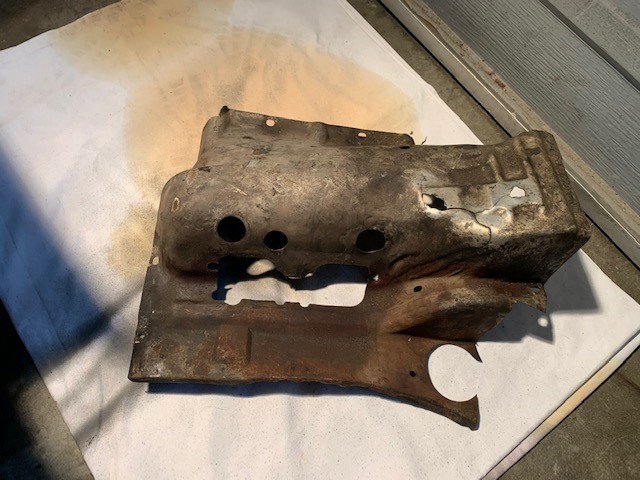 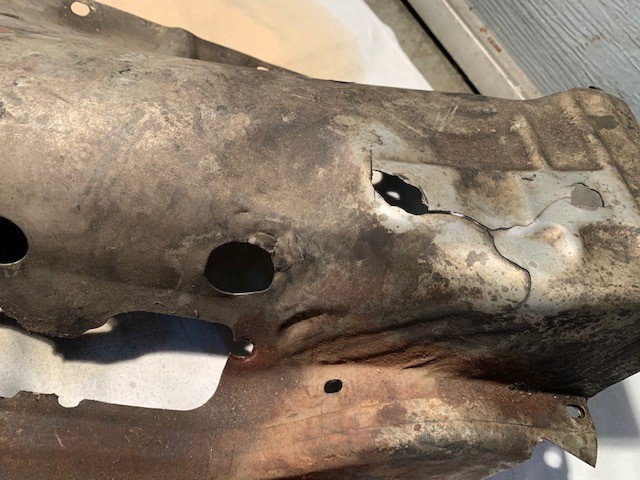 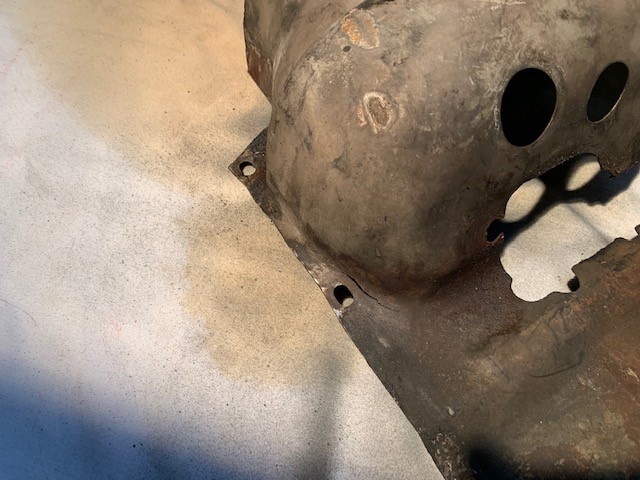 Save your original OG engine tin they say. It's the best they say. So after a few hours... I'm not kidding anyone here with these pictures, after many days I find myself with this... 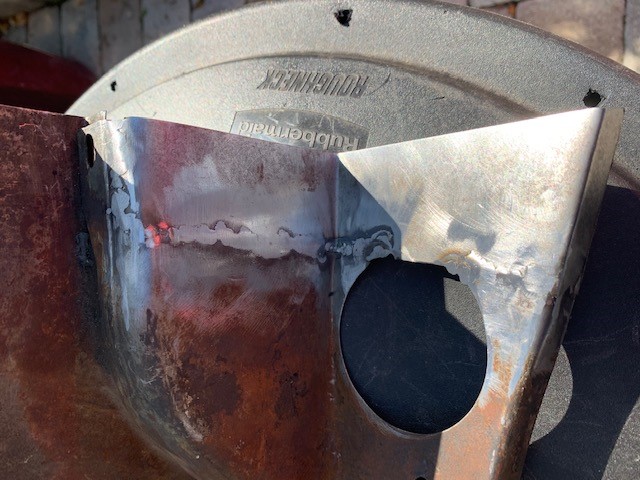 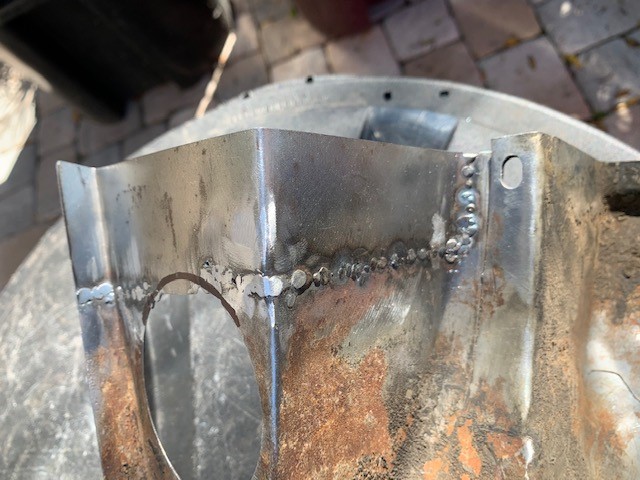 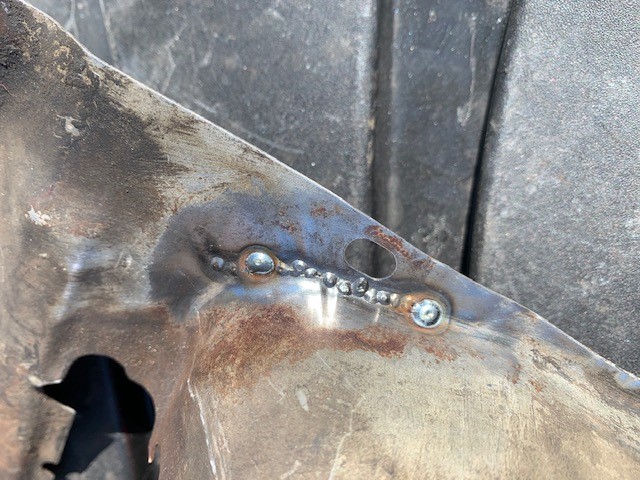 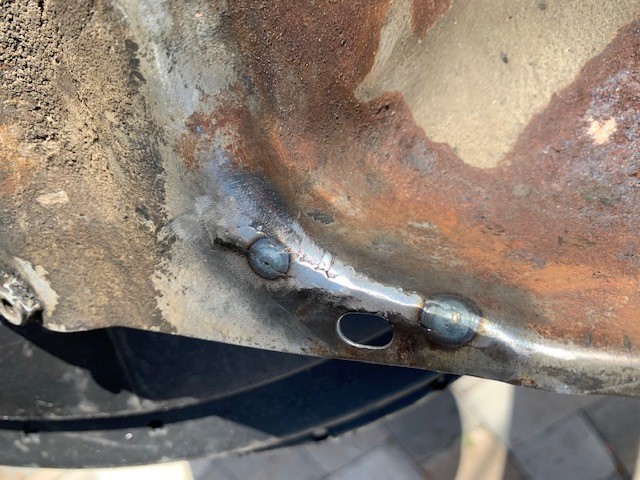 I have several questions for those with at least a few hours more experience. 1) How much more, if any, should these welds be ground down? Or, will the weld beads provide future strength to the thin, stretched sheet metal so leave as-is? 2) In order of preference, what would be the best three tools to use to grind down welds on thin sheet metal? Assume you don't have an air compressor. I don't. 3) For the top section where the coil attaches on the tin, the coil bracket uses P/N: N 010 210 13 which is M 6 x 10 hex-head bolt. Is the tin supposed to have a captured nut on the backside or just thicker sheet metal in the locations that are missing on my tin (see first few pictures). 4) Should the coil mounting location be relocated in order to avoid whatever the hell happened here? If so, where? In actuality I'm quite please with the results so far, maybe not the pace of the work, but at least the product thus far. It'll be useable tin and certainly better than it was. (IMG:style_emoticons/default/screwy.gif) This is literally the first time I have ever fabricated a patch and tried to weld anything. I'm working my way up to the easy stuff if there such a thing? I appreciate you entertaining my questions. Thanks, Sean |
  |
Replies
| Archie |
 Feb 22 2021, 07:54 PM Feb 22 2021, 07:54 PM
Post
#2
|
|
Member   Group: Members Posts: 197 Joined: 23-September 09 From: Western Canada Member No.: 10,844 Region Association: Pacific Northwest |
I recommend all new welders to get some 50 year old thin gage sheet metal to learn with. :welder: How hard could it be? In doing so, you’ll practice with voltage and wire speed, stick out, part set up, metal cleaning, contamination and porosity, work area lighting, youtube, weld grinding, fabrication, clamping, gapping, blow thru, backing materials, warping, patience and wire brushing, to name a few. What I have... How many cracks can you spot?    Save your original OG engine tin they say. It's the best they say. So after a few hours... I'm not kidding anyone here with these pictures, after many days I find myself with this...     I have several questions for those with at least a few hours more experience. 1) How much more, if any, should these welds be ground down? Or, will the weld beads provide future strength to the thin, stretched sheet metal so leave as-is? 2) In order of preference, what would be the best three tools to use to grind down welds on thin sheet metal? Assume you don't have an air compressor. I don't. 3) For the top section where the coil attaches on the tin, the coil bracket uses P/N: N 010 210 13 which is M 6 x 10 hex-head bolt. Is the tin supposed to have a captured nut on the backside or just thicker sheet metal in the locations that are missing on my tin (see first few pictures). 4) Should the coil mounting location be relocated in order to avoid whatever the hell happened here? If so, where? In actuality I'm quite please with the results so far, maybe not the pace of the work, but at least the product thus far. It'll be useable tin and certainly better than it was. :screwy: This is literally the first time I have ever fabricated a patch and tried to weld anything. I'm working my way up to the easy stuff if there such a thing? I appreciate you entertaining my questions. Thanks, Sean Hello Sean, Regarding the welding techniques, please allow me to point you in THIS direction: https://www.youtube.com/watch?v=34bPn6lfyuA...f_g&index=4 He has an absolute encyclopedia of YouTube videos covering all aspects of bodywork welding and stuff with many handy tips and tricks which I dearly wish I'd known about when I started welding! ! Your welds don't look half-bad by the way! I'm a great believer in the no body-filler school of thought but it's tough to achieve. To your questions: 1) I like to grind them down as much as possible, but that's just me! 2) See Trev's blog. He recommends a super-coarse flexible disc. I like an electric belt-sander as you can follow the weld bead. 3) There are two captive nuts, if memory serves. 4) I'll pass and let more knowledgeable types chip in. Good luck and best wishes! |
Posts in this topic
 seanpaulmc Repairing Engine Tin Feb 22 2021, 07:20 PM
seanpaulmc Repairing Engine Tin Feb 22 2021, 07:20 PM
 cary 3" 36gr RoLoc on a 2" pad. Gives you a f... Feb 22 2021, 08:34 PM
cary 3" 36gr RoLoc on a 2" pad. Gives you a f... Feb 22 2021, 08:34 PM
 malcolm2 Paint 'em and drive it. Feb 22 2021, 10:51 PM
malcolm2 Paint 'em and drive it. Feb 22 2021, 10:51 PM
 rfinegan I just spent a few hours on mine last night. And ... Feb 23 2021, 04:51 AM
rfinegan I just spent a few hours on mine last night. And ... Feb 23 2021, 04:51 AM
 Mark Henry Take a section of copper sheet or copper pipe and ... Feb 23 2021, 08:26 AM
Mark Henry Take a section of copper sheet or copper pipe and ... Feb 23 2021, 08:26 AM

 Archie
Take a section of copper sheet or copper pipe and... Feb 23 2021, 07:21 PM
Archie
Take a section of copper sheet or copper pipe and... Feb 23 2021, 07:21 PM

 Mark Henry
Take a section of copper sheet or copper pipe an... Feb 24 2021, 08:56 AM
Mark Henry
Take a section of copper sheet or copper pipe an... Feb 24 2021, 08:56 AM

 ClayPerrine
[quote name='Archie' post='2894103' date='Feb 23 ... Apr 8 2021, 11:17 AM
ClayPerrine
[quote name='Archie' post='2894103' date='Feb 23 ... Apr 8 2021, 11:17 AM

 76-914
[quote name='Archie' post='2894103' date='Feb 23 ... May 8 2021, 04:26 PM
76-914
[quote name='Archie' post='2894103' date='Feb 23 ... May 8 2021, 04:26 PM
 Robarabian Yes on the copper. Also, where you see the nice ri... Feb 24 2021, 09:09 AM
Robarabian Yes on the copper. Also, where you see the nice ri... Feb 24 2021, 09:09 AM
 rfinegan Got this a Harbor Freight for a few bucks....
Feb 24 2021, 09:26 AM
rfinegan Got this a Harbor Freight for a few bucks....
Feb 24 2021, 09:26 AM
 dr914@autoatlanta.com the passenger side 2.0 engine cylinder cover is im... Feb 24 2021, 10:09 AM
dr914@autoatlanta.com the passenger side 2.0 engine cylinder cover is im... Feb 24 2021, 10:09 AM

 Mark Henry
the passenger side 2.0 engine cylinder cover is i... Feb 24 2021, 10:46 AM
Mark Henry
the passenger side 2.0 engine cylinder cover is i... Feb 24 2021, 10:46 AM

 Superhawk996
Like this one?
BTW I have the other side as wel... Feb 25 2021, 06:58 AM
Superhawk996
Like this one?
BTW I have the other side as wel... Feb 25 2021, 06:58 AM


 Mark Henry
[quote name='Mark Henry' post='2894247' date='Feb... Feb 25 2021, 08:41 AM
Mark Henry
[quote name='Mark Henry' post='2894247' date='Feb... Feb 25 2021, 08:41 AM



 Superhawk996
The dies used to pop these pieces out were quite... Feb 25 2021, 09:31 AM
Superhawk996
The dies used to pop these pieces out were quite... Feb 25 2021, 09:31 AM



 Shivers
The dies used to pop these pieces out were quit... Apr 8 2021, 10:05 AM
Shivers
The dies used to pop these pieces out were quit... Apr 8 2021, 10:05 AM


 Jett
Like this one?
BTW I have the other side as we... Feb 25 2021, 09:10 AM
Jett
Like this one?
BTW I have the other side as we... Feb 25 2021, 09:10 AM


 Superhawk996
[quote name='Mark Henry' post='2894247' date='Feb... Feb 25 2021, 09:51 AM
Superhawk996
[quote name='Mark Henry' post='2894247' date='Feb... Feb 25 2021, 09:51 AM


 Jett
[quote name='Mark Henry' post='2894247' date='Fe... Feb 25 2021, 12:31 PM
Jett
[quote name='Mark Henry' post='2894247' date='Fe... Feb 25 2021, 12:31 PM

 914_teener
the passenger side 2.0 engine cylinder cover is ... Feb 25 2021, 09:26 AM
914_teener
the passenger side 2.0 engine cylinder cover is ... Feb 25 2021, 09:26 AM


 Bleyseng
[quote name='Mark Henry' post='2894247' date='Feb... Apr 7 2021, 08:20 PM
Bleyseng
[quote name='Mark Henry' post='2894247' date='Feb... Apr 7 2021, 08:20 PM

 seanpaulmc Hello Mark Henry -
Could you scoot that tin arou... Apr 7 2021, 06:06 PM
seanpaulmc Hello Mark Henry -
Could you scoot that tin arou... Apr 7 2021, 06:06 PM

 Mark Henry
Hello Mark Henry -
Could you scoot that tin aro... Apr 8 2021, 09:32 AM
Mark Henry
Hello Mark Henry -
Could you scoot that tin aro... Apr 8 2021, 09:32 AM
 bkrantz For grinding welds on sheet metal I like flappy sa... Feb 24 2021, 10:02 PM
bkrantz For grinding welds on sheet metal I like flappy sa... Feb 24 2021, 10:02 PM

 bbrock
For grinding welds on sheet metal I like flappy s... Feb 25 2021, 08:37 AM
bbrock
For grinding welds on sheet metal I like flappy s... Feb 25 2021, 08:37 AM
 bbrock I never thought about it before but that right fro... Feb 25 2021, 08:49 AM
bbrock I never thought about it before but that right fro... Feb 25 2021, 08:49 AM
 VaccaRabite What I want to know is - what on earth caused thos... Feb 25 2021, 09:52 AM
VaccaRabite What I want to know is - what on earth caused thos... Feb 25 2021, 09:52 AM

 Superhawk996
What I want to know is - what on earth caused tho... Feb 25 2021, 09:58 AM
Superhawk996
What I want to know is - what on earth caused tho... Feb 25 2021, 09:58 AM

 Mark Henry
What I want to know is - what on earth caused tho... Feb 25 2021, 10:01 AM
Mark Henry
What I want to know is - what on earth caused tho... Feb 25 2021, 10:01 AM

 914sgofast2
What I want to know is - what on earth caused th... Apr 7 2021, 06:52 PM
914sgofast2
What I want to know is - what on earth caused th... Apr 7 2021, 06:52 PM
 seanpaulmc The area of concern I have for this piece of tin i... Apr 8 2021, 11:42 AM
seanpaulmc The area of concern I have for this piece of tin i... Apr 8 2021, 11:42 AM
 Mark Henry The tin is correct in that area, you're good t... Apr 8 2021, 11:45 AM
Mark Henry The tin is correct in that area, you're good t... Apr 8 2021, 11:45 AM
 wonkipop mate
you are a hero for working out how to do thi... Apr 9 2021, 04:09 AM
wonkipop mate
you are a hero for working out how to do thi... Apr 9 2021, 04:09 AM

 930cabman
mate
you are a hero for working out how to do th... Apr 9 2021, 05:01 AM
930cabman
mate
you are a hero for working out how to do th... Apr 9 2021, 05:01 AM
 seanpaulmc Finally got back to finishing up the tin repair.
... Apr 19 2021, 06:41 AM
seanpaulmc Finally got back to finishing up the tin repair.
... Apr 19 2021, 06:41 AM
 seanpaulmc When taking the Tin off the engine, I have this sm... Apr 19 2021, 06:51 AM
seanpaulmc When taking the Tin off the engine, I have this sm... Apr 19 2021, 06:51 AM
 seanpaulmc Are the heat control boxes salvageable?
Thank... Apr 19 2021, 06:57 AM
seanpaulmc Are the heat control boxes salvageable?
Thank... Apr 19 2021, 06:57 AM

 Mark Henry
Are the heat control boxes salvageable?
Than... Apr 19 2021, 07:40 AM
Mark Henry
Are the heat control boxes salvageable?
Than... Apr 19 2021, 07:40 AM
 930cabman Great job, can I send a couple of mine in for repa... Apr 20 2021, 07:00 AM
930cabman Great job, can I send a couple of mine in for repa... Apr 20 2021, 07:00 AM

 seanpaulmc
Great job, can I send a couple of mine in for rep... Apr 21 2021, 05:07 PM
seanpaulmc
Great job, can I send a couple of mine in for rep... Apr 21 2021, 05:07 PM

 930cabman
[quote name='930cabman' post='2909442' date='Apr ... Apr 21 2021, 05:12 PM
930cabman
[quote name='930cabman' post='2909442' date='Apr ... Apr 21 2021, 05:12 PM
 Arno914 Any "normal" 914 was long rusted to piec... Apr 20 2021, 08:37 AM
Arno914 Any "normal" 914 was long rusted to piec... Apr 20 2021, 08:37 AM
 seanpaulmc Moving onto the other side...
This is the main to... Apr 21 2021, 05:19 PM
seanpaulmc Moving onto the other side...
This is the main to... Apr 21 2021, 05:19 PM

 930cabman
Moving onto the other side...
This is the main t... May 8 2021, 03:33 PM
930cabman
Moving onto the other side...
This is the main t... May 8 2021, 03:33 PM
 seanpaulmc Bump for questions about the 1-2 tin.
How much do... Apr 23 2021, 11:39 AM
seanpaulmc Bump for questions about the 1-2 tin.
How much do... Apr 23 2021, 11:39 AM

 dirk2056 Can someone post pictures of what profile the tins... May 8 2021, 10:52 AM
dirk2056 Can someone post pictures of what profile the tins... May 8 2021, 10:52 AM
 seanpaulmc I truly appreciate all the tips and support on wel... May 8 2022, 05:18 PM
seanpaulmc I truly appreciate all the tips and support on wel... May 8 2022, 05:18 PM
 Mark Henry
I truly appreciate all the tips and support on we... May 8 2022, 05:48 PM
Mark Henry
I truly appreciate all the tips and support on we... May 8 2022, 05:48 PM  |
9 User(s) are reading this topic (9 Guests and 0 Anonymous Users)
0 Members:

|
Lo-Fi Version | Time is now: 28th November 2024 - 12:31 PM |
Invision Power Board
v9.1.4 © 2024 IPS, Inc.








